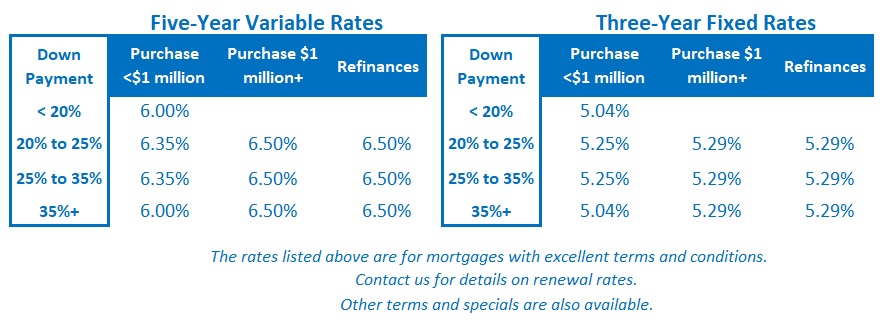The Bank of Canada’s First Rate Cut Should Not Be Far Off
March 4, 2024Five Important Updates on Canadian Mortgage Rates
March 25, 2024
Last week the Bank of Canada (BoC) held its policy rate steady at 5%.
That decision was widely expected, but the Bank’s continued use of hawkish language in its accompanying statement was not.
The BoC will need to start cutting its policy rate soon if it still intends to skate where the puck is going. Our economy has weakened considerably of late and inflation pressures have continued to ease.
Most of our remaining inflation pressure is coming from shelter costs, and most importantly within that component, from mortgage interest costs (which have increased by approximately 28% year-over-year).
TD Bank recently noted that our Consumer Price Index (CPI) came in at 1.5% in January with shelter costs excluded, and economist Ben Rabidoux calculated that if just mortgage interest costs are excluded, that month’s CPI print came in right at the Bank’s 2% target.
The BoC’s policy statement again acknowledged the economic trends that were widely cited in the lead-up to its meeting – slowing global growth, higher bond yields (which act as their own form of financial tightening), and easing inflation pressures at home and abroad. In addition, the Bank noted that our economic growth was “weak and below potential”, that domestic consumer demand and business investment contracted last quarter, and that there are early signs that “wage pressures may be easing”.
But all of that slowing momentum was not enough to sway the Bank.
It stated that core inflation is still too high and emphasized the need “to see further and sustained easing”. At his accompanying press conference, Governor Macklem added, “we need to give higher rates more time to do their work”.
Sidenote #1: This was the first time the BoC conducted a press conference at a policy meeting that didn’t include the release of a Monetary Policy Report (MPR). Until last Wednesday, the Bank would issue its decision, and then, as I wrote in last week’s post, its members would leave quietly through the proverbial back door as if they had a bus to catch.
While this newly added press conference was supposed to help “keep Canadians informed”, every answer given merely parried back to the Bank’s written statements. Despite breaking precedent by including the press conference, BoC Governor Macklem and Deputy Governor Rogers seemed determined to offer nothing new. Bluntly put, they might as well have caught an earlier bus and skipped the press conference.
Sidenote #2: Here are two important questions I hope the attending media asks the next time: 1) Why does the BoC include mortgage interest costs in its CPI basket when many other central banks do not, and 2) Why does the BoC also assign a higher weighting to total shelter costs than other central banks?
If the BoC wants to allow more time for higher rates to slow our economy further, it won’t take long.
As I wrote last week, only about half of Canadian mortgage borrowers have had to renew into higher rates thus far, and the resulting higher debt payments are already absorbing a record amount of their discretionary spending.
The coming rate resets will have an even greater proportionate impact on incomes because they will predominantly apply to borrowers who will be renewing ultra-low pandemic rates. Unless rates fall sharply, and soon, discretionary spending will be crimped even more than it is now. (As further evidence of growing distress, mortgage, credit card, and car-loan defaults have spiked higher of late, and so have business bankruptcies.)
If the BoC isn’t satisfied by this point that our remaining inflation pressures, as they are currently comprised, have us tracking on “a clear path back to 2%”, then the odds that it will overtighten have significantly increased.
That’s because most of our inflation is coming from rising shelter costs, which are the result of a structural supply/demand imbalance which the Bank’s policy rate can’t impact, and by increasing mortgage interest costs, which won’t abate any time soon because of the rate resets still to come.
Put more simply, most of our remaining inflation pressure is either immune to higher rates or is being directly caused by them (which conjures the image of a dog chasing its tail).
If the Bank overtightens and causes a sharper-than-expected slowdown, which seems increasingly likely, it won’t then just need to stop restricting growth, it will need to start stimulating it. In other words, the longer the BoC waits to enact its first rate cut, the lower its policy rate will then have to go to course correct.
The BoC’s policy rate now stands at 5%, and by the Bank’s own estimate, its neutral rate (which is the policy-rate rate level that neither stimulates economic growth nor restricts it), is in the 2.5% to 3% range.
If the Bank needs to shift its policy rate past neutral into a stimulative range, it will likely need to cut by 3% (or more) to get there.
Mortgage Selection Advice
If you’re willing to pay an upfront rate premium and can tolerate a higher-risk option, I think variable rates are well worth considering. While we can never be certain how things will play out, I think the odds that the BoC will substantially cut its policy rate have now increased, along with the likelihood that variable rates will produce the lowest total interest cost over a typical five-year term.
On the other hand, if you’re a more conservative borrower who is still concerned that stickier inflation, especially the kind that policy rates can’t affect, will keep rates higher for longer, I think a three-year term still represents the best bet among today’s available fixed-rate options. The Bottom Line: Government of Canada bond yields drifted lower last week but not by enough to move most lenders’ fixed rates.
The Bottom Line: Government of Canada bond yields drifted lower last week but not by enough to move most lenders’ fixed rates.
An early start to the spring market has caused five-year variable rate discounts to widen a little of late.
While variable rates still come at an initial premium to fixed rates, I think the BoC’s hawkish stance increases the odds that borrowers who are patient will be well rewarded over their full terms.







